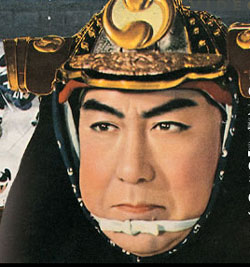 Chiezo's most popular entry into the tale of the brave forty-seven ronin was the twin-film Chushingura: Ouka no maki, & Chushingura: kikka no maki (1959), shown in English as The Great Avengers & as The Forty-seven Masterless Samurai Part I & Part II. Chiezo's most popular entry into the tale of the brave forty-seven ronin was the twin-film Chushingura: Ouka no maki, & Chushingura: kikka no maki (1959), shown in English as The Great Avengers & as The Forty-seven Masterless Samurai Part I & Part II.
This Toei Studios "anniversary film" is available as an excellently remastered two-disc set with English subtitles. It's a wonderful version with the basics of the tale all present, very little in the way of interpretiveness.
It's a good version to start with if you're a novice to samurai films, but also captivating for samurai film buffs who've seen the story several times & would like to see the excellent Chiezo Kataoka in the story's best role of Oishi the chief vassal & leader of the brave 47.
Likely only us die-hards want to see every possible version, & the more typical viewer will be satisfied to see either this version starring Cheizo, or Kunio Watanabe's The Loyal 47 Ronin (Chushingura, Daiei, 1958) with a very fine cast including Raizo Ichikawa as Lord Asano; or Hiroshi Inagaki's Vendetta of the Loyal 47 Ronin Parts 1 & 2 (Chushingura: Hana no Maki & Chushingura: Yuki no Maki, Toho, 1962), or Kenji Fukasaku's Swords of Vengeance: The Fall of Ako Castle (Ako-jo danzetsu, Toei, 1978), all equally good doorways into this important story.
Any of those would prepare the viewer for more interpretive takes on the famous heroic tale, of which there are a great many.
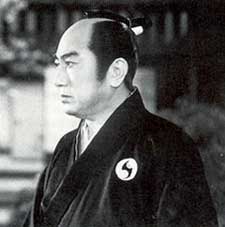 The 1959 Toei Studios version was handsomely staged, appealing scored, bringing all of Toei's biggest actors on board. That included young new stars like Kinnosuke Nakamura & Hashizo Okawa, & old hands who had long been appearing in versions of Chushingura, such as Denjiro Okochi, Utaemon Ichikawa, & Ryunosuke Tsukigata. The 1959 Toei Studios version was handsomely staged, appealing scored, bringing all of Toei's biggest actors on board. That included young new stars like Kinnosuke Nakamura & Hashizo Okawa, & old hands who had long been appearing in versions of Chushingura, such as Denjiro Okochi, Utaemon Ichikawa, & Ryunosuke Tsukigata.
Kinnosuke projects a sweet, tearful, well intending, decent young Lord Asano, perhaps too close to whiny rather than forbearing. His failure to observe the more corrupt aspects of Edo castle etiquette forms the basis of his trouble. An inadequate bribe accidentally wins him the emnity of greedy Lord Kira, who withholds necessary instructions on ceremonial requirements, & insults Asano personally at every opportunity.
Asano's rural region of Ako does not provide much opportunity to learn the more highly ritualized greeting rituals, so he has to be patient in the face of humiliation, striving to win Kira's instructions. Kira instructs Asano on how to prepare the guest resident, & pointedly informs him it would be regarded as too ostentatious to replace the tatami matting. The night before receiving dignitaries from Kyoto, Asano learns that the mats will be expected to be fresh & new.
It hardly seems possible to have two-hundred fresh mats sewn in a single night. But Ryotaro Otomo's character, Yasobei, takes over the mission, waking all the tatami weavers he can locate, & getting them to work through the night, finishing with scarcely a minute to spare.
At every turn Asano is similarly misled until at last he snaps, drawing his shortsword within Edo castle, injuring Kira in the forehead & shoulder before he can be restrained.
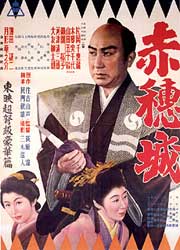 The repercussions include not just the tragedy of a decent young lord having to commit seppuku, but it also means the forfeiture of Ako castle & lands & dissolution of the clan itself. The repercussions include not just the tragedy of a decent young lord having to commit seppuku, but it also means the forfeiture of Ako castle & lands & dissolution of the clan itself.
The devotion of Asano's retainers, old & young, is endearing. The tone of this film version is a bit odd in that the vassals from the start had been protecting Asano as though he were frail or personally incapable. And Kinnosuke has been playing Asano as so tearfully upset that he does seem at times a weak figure, whose savage outburst was thus reduced to the result of tantrum rather than a matter of honor.
His vassals have to admit that what their lord has done was wrong. The consequences are exclusively his fault for permitting Kira to get to him. But fair judgement would have required the equal punishment of Kira, whose connections win him a completely one-sided judgement against Asano.
Various takes on the story of the forty-seven ronin highlight different aspects of their deeds, & this version makes a great to-do about the one-sidedness of the judgement that requires protest against the government.
A few years earlier when Japan was still at war, Chushingura could not possibly have been produced as a criticism of government, but only as upholding the samurai value of absolute faithfulness & obedience to one's lord. It was always part of the story, but it is much more strongly asserted here that the brave forty-seven are not seeking mere revenge against one repulsive elderly foe. There would be nothing valorous about killing one obnoxious old man. Rather, this is a symbolic stand against the government itself.
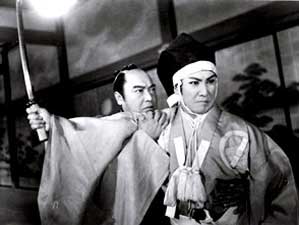 Lady Asano (Michiyo Kogure) inspires calm when the vassals are thrown into near panic, tears accumulating among them. Asano's integrity rises magnificently to the staggeringly emotional as he prepares to commit seppuku. Lady Asano (Michiyo Kogure) inspires calm when the vassals are thrown into near panic, tears accumulating among them. Asano's integrity rises magnificently to the staggeringly emotional as he prepares to commit seppuku.
Gengoemon Kataoka is the vassal who comes to say farewell under the flowering cherry trees, receiving Asano's apologies for bringing catastrophe upon those most faithful to him.
The belly-slitting & beheading are not shown on screen, for the camera moves upward to show falling cherry blossoms. It's a cliche cut-away perhaps, but especially apropos of Lord Asano who is foremost of all samurai associated with the brief spring glory of cherry blossoms.
Only now are we introduced to the character of Oishi, the chief vassal at Ako Castle who receives the messenger from Edo with the catastrophic news. He will dominate the rest of Part I & all of Part II as one of the greatest historical personages to ever be transformed into an actor's dream role.
The range of emotion requires an actor to convincingly go from stoic sadness to resolution to faked womanizing drunkenness to ultimate leadership, providing for scene after scene in which Cheizo Kataoka shows his stuff as an actor. He never chews scenery. He was capable of overacting, to be sure, but this time he lets this great character be completely real.
Oishi is always played by a mature actor. Cheizo had in his youthful career played the doomed Lord Asano, & aged into the finer role of Oishi. Kinnosuke, the Asano of this feature, would likewise eventually age into the role of Oishi in 1978's Swords of Vengeance: The Fall of Ako Castle.
Where other actors convey their characters grief in broad strokes, Cheizo's Oishi seethes emotion within stoic firmness. He conveys more sitting still than others manage by throwing themselves upon mats & bursting into lamentations. He was truly a great star, with a career that spanned more than fifty years.
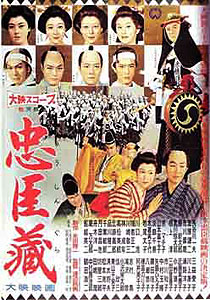 A banished vassal, Fuwa, returns to Ako. He is scruffy from his wandering hardships, but one of the clan's strongest swordsmen, & most devoted despite his banishment. A banished vassal, Fuwa, returns to Ako. He is scruffy from his wandering hardships, but one of the clan's strongest swordsmen, & most devoted despite his banishment.
Not all the vassals are so eager to convey valor. Of Asano's hundreds of vassals, there were few who came to Ako Castle on the day assigned for their mass suicide to follow their lord. By their commitment, Oishi knows their resolve, & only then reveals his actual plan.
The government will be petitioned to re-instate the Asano clan through their lord's brother. The end result of this petition is a foregone conclusion. Only then will they go after Kira's head.
Hashizo Okawa, the young star of the Aoi Shingo series, plays one of the forty-seven, Kinemon, who is in love with Taka, played by songstress Hibari Misora. Hibari does not have a singing role in such a serious film as this, though there's a token moment on the soundtrack in which she will be heard performing a plaintive song.
Taka is the daughter of the vassal Heizaemon. He is unwell & will commit seppuku on the day of revenge-taking since he is bedridden. Kinemon & Taka will have a tiny private marriage ceremony; but, knowing death is Kinemon's path, the marriage is one of parting rather than of a new life together. Taka will more or less take her father's place in the mission, penetrating Kira's household as a maid in order furtively to obtain the floor plans of the mansion.
As Part II opens, Oishi has for some months lived a life of dissolution in the pleasure district, so that authorities will stop being suspicious of his intentions, throwing Kira's & the government spies off the scent.
Not everyone is convinced by Oishi's performance. Even if he has truly fallen into such foolish behavior without desire to avenge his late lord, there are yet many masterless samurai who cannot forget Asano. Horibe, for prime example, is a masterful swordsman, whose existence is alone sufficient to keep paranoia high in Kira's household.
Officials are slow to make public their final decision against the Asano clan. In the meantime some of the loyal forty-seven begin to lose faith in Oishi's sincerity. Yahei (Yasobei''s seventy-five year old father) especially fears he will not live long enough to obtain revenge, & nearly causes harm to the plan by acting with an impatient few. But in the autumn the final decision comes down from the government. By winter the brave forty-seven will be gathering together for their famous march to Kira's mansion.
The youngest of the forty-seven is sixteen year old Yato Emoshichi. He was initially rejected as too young, but his sincerity could not be overlooked. Chikara, Oishi's son, is second youngest. Riko, Oishi's wife, must part with her son, after Oishi divorces her so that her family will not suffer the consequences of his actions.
One of the many effectively emotional scenes is the tearful sequence in which Chikara runs down the road to catch up with his mother & bid her farewell. She with tragic stoicism counsels him, "Attain your goal!" as his baby brother & baby sister begin weeping.
Beautiful Kinemon (Okawa) proudly displays himself in his revenge-garments saying, "Grandmother! Look at me! I'm going to fulfill my destiny!" With tears of happiness she says, "I'm glad I lived to see you achieve your goal." Other such sad farewells are reenacted, because this is not a film of fast-paced action, but of a profound moral, though violent event, & the effects the preparations have had on everyone involved.
Oishi makes a farewell visit to Lady Asano, though he dares not say aloud what is pending, as spies could be anywhere. One of Lady Asano's maids takes Oishi to task for his cowardly refusal to avenge their lord. But Lady Asano hushes her, having realized this is Oishi's last farwell.
Their happiness of Asano's ronin on that fateful day is almost weird, considering that they're aware they'll all have to commit seppuku after the revenge raid is completed.
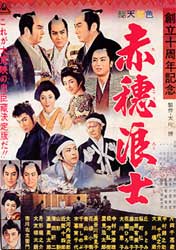 Nightfall. Snowfall. Oishi leads the brave forty-seven through the streets of Edo. It's almost unbearable in its combination of suspense & boldness & fateful inevitability, yet in this take, strikingly without sorrow.
Nightfall. Snowfall. Oishi leads the brave forty-seven through the streets of Edo. It's almost unbearable in its combination of suspense & boldness & fateful inevitability, yet in this take, strikingly without sorrow.
Swords flash in darkness as the brave forty-seven charge through the snowy courtyard & into the mansion, slaying Kira's guards & clansmen while Kira hides. At one point Yasobei (Otomo) comes worriedly forth exclaiming "Father!" but the aged samurai, beset by enemies, replies only, "Idiot! I'm having a good time. Don't get in my way!"
In the main, this climax is all fast swaths of swordplay & spear action, void of dialogue. The swift momentum goes on & on, then pauses while the ronin search for Kira's hiding place in a garden shed. A subdued scene concludes their revenge, of Kira's head at last upon a pole.
Generally there is a whole long act following the climactic revenge, a return to the story's overall quiescence while the brave forty-seven prepare for expiation suicide. Toei Studios elected to end the story with the forty-seven ronin atop a bridge giving their victory shout, though of course everyone would know the story didn't really end at that triumphant moment. Every brave man will soon be dead, though even then, it will be the government, & not these ronin, that will be most cowed.
copyright © by Paghat the Ratgirl
|
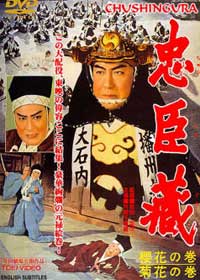


 The repercussions include not just the tragedy of a decent young lord having to commit seppuku, but it also means the forfeiture of Ako castle & lands & dissolution of the clan itself.
The repercussions include not just the tragedy of a decent young lord having to commit seppuku, but it also means the forfeiture of Ako castle & lands & dissolution of the clan itself.

